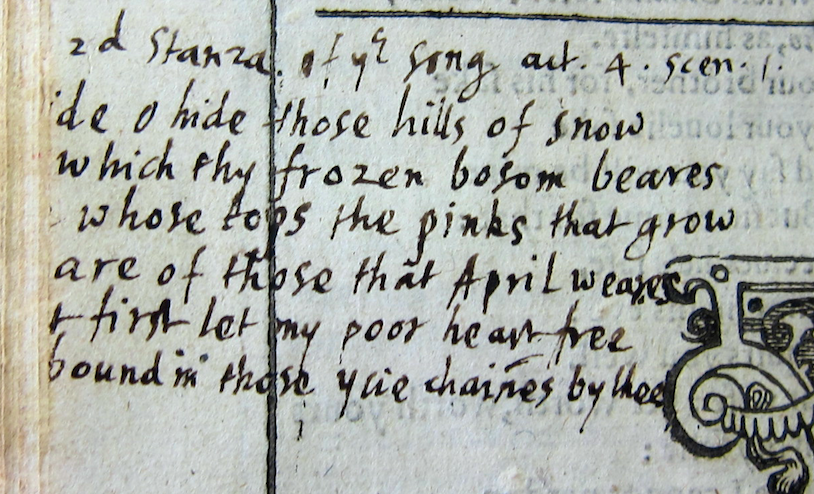It’s always annoying when someone tries to claim that they’ve discovered a lost literary artefact. I was myself a little bit brutal when, five years ago, we were treated to the supposed rediscovery of Shakespeare’s dictionary. In this as in other cases, there’s usually a lot of wishful thinking, plus copious spinning of the evidence to make it seem plausible, and elision of anything that doesn’t seem to fit. However, I’m going to make my own unwise pronouncement on the basis of just a few hours of research. I’m going to claim to have identified John Milton’s copy of the Shakespeare First Folio of 1623.
In a recent article (‘Vide Supplementum: Early Modern Collation as Play-Reading in the First Folio’, in Kathy Acheson, ed., Early Modern English Marginalia [London: Routledge, 2019]), Claire M. L. Bourne offers a rich analysis of the manuscript annotations in a copy of the Folio now at the Free Library of Philadephia. She demonstrates that the annotations are highly unusual in character, having been added by a reader who was very attentive to misprints and metrical errors, and who in two cases–those of Romeo and Juliet and Hamlet–was comparing the Folio text with the text supplied by a Quarto edition of each play (Q5 [1637] in the case of the former, and one of Q3-5 [1611-37] for the latter). In several cases, the reader corrected the Folio from the Quartos, but his emendations were by no means slavish, and were accompanied by other textual changes that seem to have been inspired by his own sense of what was needed in the particular context.
The reader also added a few smart cross-references, to Tottel’s Songs and Sonnettes for the Gravedigger’s song in Hamlet, and to Samuel Purchas’s Purchas his Pilgrimes for the identity of The Tempest‘s deity Setebos; and he supplied the second verse of the song that is sung to Mariana in Measure for Measure. (Someone, perhaps a different reader or the same reader using a display hand, transcribed the Prologue to Romeo and Juliet, which is missing from the Folio text). Finally, our reader added marginal markings to all of the plays except for Henry VI 1-3 and Titus Andronicus. Bourne suggests that these are not marks for cuts but are instead commonplace markers, indicating passages of special note or broad applicability. On the basis of the various texts cited and of the binding, which likely dates from the early Restoration, Bourne tentatively dates the annotations between c. 1625 and some point in the 1660s.
So this reader is intelligent and assiduous. But the evidence that makes me want to suggest that it’s Milton is strictly palaeographical. This just looks a lot like Milton’s hand. Here I’m going to offer some words and letter-forms for comparison. Let’s start small and relatively unrevealing, with ‘the’. On the left we have the Folio, on the right the Trinity manuscript.
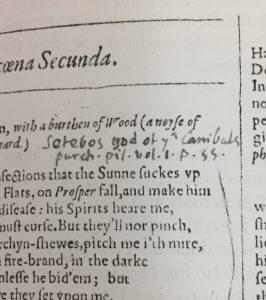
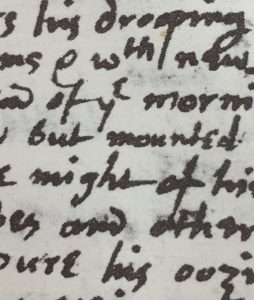
With that citation on the left, and its neatly spaced reference by volume and page to Purchas, we might compare this citation of Machiavellis’ Arte della Guerra in Milton’s commonplace book in the British Library:
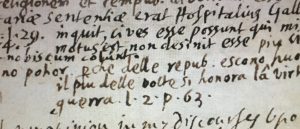
(The commonplace book also makes reference to the same first volume of Purchas, but since everyone read Purchas this may not mean very much. Having a cross-reference for a reference to Setebos does seem quite sophisticated, though).
Now let’s look at some more specific words. At one point in the text of Measure for Measure, Milton struggles to make sense of Angelo’s claim that ‘these blacke Masques / Proclaime an en-shield beauty ten times louder / Then beauty could displaied’. He changes ‘en-shield’ to ‘enshrin[ed]’ or ‘enshrin[‘d]’ (the page has been trimmed in binding, so not all of the word survives). Here is the word in the Folio, and next to it is ‘shrine’ from the Trinity MS (sadly wordpress keeps rotating the images, so please crank your head through 90 degrees):
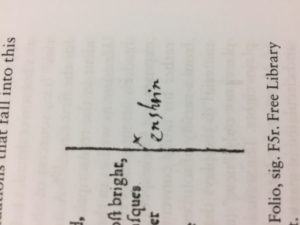
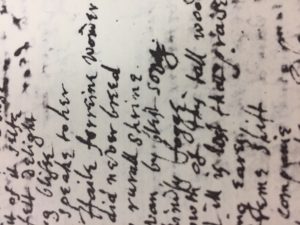
Another comparison: ‘morne’ (Trinity) and ‘morn’ (Hamlet):
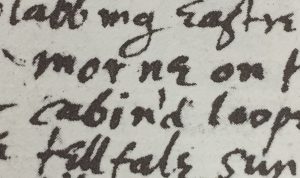
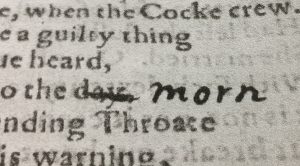
Those are perhaps pretty equivocal (it’s something about the tidy separation and discreteness of the letter forms, rather than the forms themselves, that might make us wonder). But here’s ‘Hence will I’ (in the Folio) and ‘will I trie’ (in Trinity):
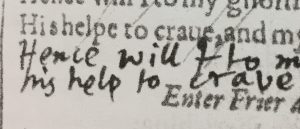
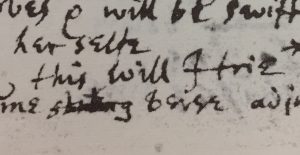
And here’s ‘he’ (Trinity MS/Folio), which seems to me quite telling in the way that the right foot of the ‘h’ doesn’t quite get to the ground before it heads up into the ‘e’:
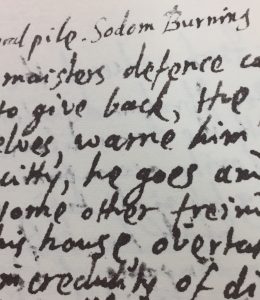
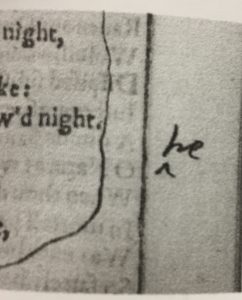
While we are going minute, we might also note that Milton has an enlarged italic hand, sometimes rather scratchy, sometimes quite elegant, that he uses for headings and suchlike. Compare the ‘R’ in the speech-heading for ‘Romeo’ in the Folio and another ‘R’ from the commonplace book:
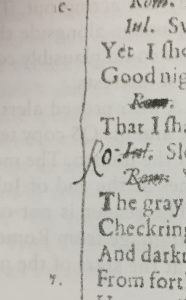
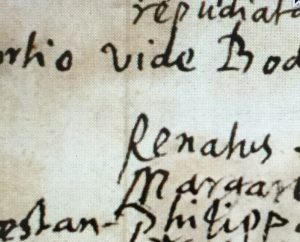
Finally we could look at the way Milton corrects things, in the Philadelphia Folio and in the corrected copy of ‘Lycidas’ in Cambridge University Library (Adv.d.38.5). It would be wrong to claim any easy overlap here–one of Bourne’s points is that the annotator of the Folio seems to be adding new readings while leaving the original to stand, so as to suggest that both are possible. But still, here is ‘Lycidas’ on the left and the Folio on the right:

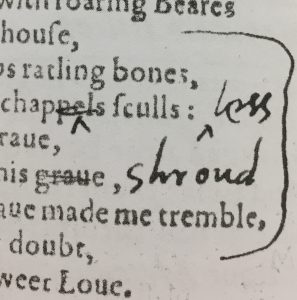
Obviously, in the style of this kind of analysis, I’ve suppressed all the information that doesn’t with fit my claims. One interesting thing (confessing for a moment) is that the annotator of the Folio seems to use the ‘modern’ Italianate form of ‘e’ rather than the ‘Greek’ epsilon-shaped ‘e’, which Milton uses a lot in the poems of the Trinity manuscript, though rather less in the prose. Wishfully, I’d suggest that this might be due to his desire to imitate the forms of print when annotating. Palaeographers have also suggested that Milton dropped Greek-‘e’ after he returned from a visit to Italy in 1639, so that detail might also allow us to date the annotations.
The Catalogue of English Literary Manuscripts lists nineteen books that have been thought to survive from Milton’s library, though many of those are lost, spurious or disputed. The description of the annotations in one of these, Heraclides of Pontus’ Allegoriae (1544), now held at the University of Illinois at Urbana-Champaign, sounds at least promising. One description refers to lots of curved vertical pen-strokes, perhaps akin to those that fill the margins of the Folio. But nobody, in the age before digital cameras, took photos of curved vertical pen-strokes.
If this book is what I think it is, it’s quite a big deal, since Shakespeare was, as we know, a huge influence on Milton. The younger poet paid tribute to his forebear in an epitaph published in the Second Folio of 1632, in which he testified to the ‘wonder and astonishment’ that Shakespeare created in his readers. Milton learnt so much from Shakespeare–how to write nature poetry; how to create charismatic villains like Comus, or Satan in Paradise Lost; how to sculpt taut, tense argumentative exchanges between speakers locked in verbal combat–though their relationship has often described as fraught and agonistic in itself, with Milton struggling to break free from his brilliant precursor. Perhaps the most obvious objection to my proposal is that the Free Library of Philadelphia Folio isn’t quite interesting enough to be Milton’s. Wouldn’t his copy be bristling with cross-references, packed with smart observations and angrily censorious comments? To this I have no response, except that maybe (as the epitaph claims) he was just wowed and struck dumb by Shakespeare. Or perhaps he saved those kinds of interventions for his Quartos…
Postscript 11/9/19: I’ve received a very positive response from several distinguished Miltonists who are confident that this identification is correct–and have been roundly rebuked for understating the significance of the discovery. On the basis of his knowledge of the development of Milton’s hand, Will Poole (who a few years back discovered the poet’s copy of Boccaccio’s Life of Dante) has suggested that the earliest handwritten addition (the prologue to Romeo and Juliet) probably dates from the early 1630s, but that the bulk of the annotations were likely made in the 1640s. So this is probably a re-reading (or several re-readings) rather than a first reading, coinciding with a time of political upheaval, when Milton was writing some of his most powerful polemical prose. My concluding comments on how the volume may be ‘not interesting enough’ will also need to be revised, given the density and detail of the annotation to this copy. More to follow.
Postscript 12/9/19: Am adding in some higher-quality images below; these were generously shared by Claire M. L. Bourne, and are posted here with the kind permission of the Free Library of Philadephia.
